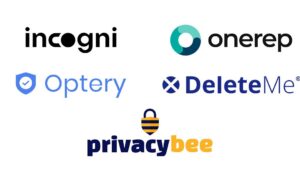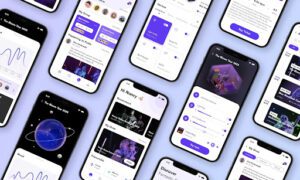Welcome to the future! 2025 is just around the corner, and with it comes a whole new world of technology that will revolutionize our lives in ways we can’t even fathom. From mind-boggling advancements in Artificial Intelligence (AI) to mind-reading gadgets, this blog post will take you on an exhilarating journey into the exciting technology trends that are set to shape our future. So buckle up, sit tight, and get ready to explore what lies ahead – because trust us, you don’t want to miss out on being part of “The Next Big Thing”!
Introduction
Technology is constantly evolving, and with each passing year, we are witnessing groundbreaking advances that are changing the world as we know it. From artificial intelligence to virtual reality, these cutting-edge technologies have not only transformed the way we live and work but also presented us with endless possibilities for the future.
The rapid pace of innovation has left many wondering about what could be the next big thing in technology. By staying informed and keeping up with the latest developments, you can gain an edge in this rapidly changing landscape and prepare yourself for what lies ahead.
Emerging Technology Trends to Watch: Artificial Intelligence, Machine Learning, and Robotics
Emerging technology is constantly changing and evolving, shaping the way we live, work, and interact with the world. In recent years, there has been a significant focus on artificial intelligence (AI), machine learning (ML), and robotics – three groundbreaking technologies that are transforming industries across the globe. These emerging trends have captured the attention of tech enthusiasts, business leaders, and consumers alike, and they are poised to become even more prevalent in the future.
Artificial Intelligence (AI)
Artificial intelligence refers to computer systems that can perform tasks that normally require human intelligence such as problem-solving, decision making, and natural language processing. AI has made tremendous advancements in recent years thanks to innovations in deep learning algorithms and big data processing. This technology has been successfully applied in various industries including healthcare, finance, transportation, and retail.
One of the most exciting applications of AI is machine learning – a subset of AI that focuses on teaching machines how to learn from data without explicitly programming them. Machine learning algorithms can continuously improve their performance through experience by analyzing large datasets and identifying patterns that enable them to make accurate predictions or decisions.
Furthermore, the integration of AI with other cutting-edge technologies such as natural language processing (NLP) and computer vision has led to the development of virtual assistants like Siri or Alexa which can understand voice commands and respond accordingly. Additionally, AI-powered chatbots have revolutionized customer service by providing 24/7 support through text-based interactions.
Machine Learning (ML)
As mentioned earlier , machine learning is a subset of AI that enables machines to learn from data without human intervention. ML algorithms use statistical techniques to identify patterns and make predictions or decisions. The more data the algorithm receives, the better it becomes at its task.
In addition to its applications in AI-powered virtual assistants and chatbots, ML is also widely used in predictive analytics, fraud detection, recommendation systems, and autonomous vehicles.
One of the most notable advancements in ML technology is the concept of deep learning – a specialized form of ML that uses multiple layers of artificial neural networks to learn and make complex decisions. Deep learning has been instrumental in achieving breakthroughs in areas such as image recognition, natural language processing, and speech synthesis.
Robotics
Robotics refers to the design, construction, operation, and use of robots. These are programmable machines that can automatically perform tasks by interacting with their environment. Robots can be controlled using sensors and programming languages to carry out actions such as movement, grasping objects or completing repetitive tasks.
Traditionally used in manufacturing for tasks such as assembly line work or welding, robotics has expanded into other industries such as healthcare where they are used for surgical procedures and assistive devices for rehabilitation purposes.
The combination of AI and robotics has resulted in the development of intelligent robots that can learn from their surroundings and perform complex tasks. These robots are being deployed in industries such as logistics, agriculture, and mining, where they can work alongside humans or in autonomous mode.
The Impact of 5G and Internet of Things on Our Daily Lives
In recent years, advancements in technology have had a significant impact on our daily lives. From smartphones to smart homes, we are constantly surrounded by devices and gadgets that make our lives easier and more convenient. However, there are two technological developments that are set to revolutionize the way we live even further – 5G and the Internet of Things (IoT).
5G is the next generation of mobile internet connectivity, offering faster speeds and more reliable connections than its predecessor, 4G. It has been hailed as a game-changer for various industries like healthcare, transportation, and manufacturing. But what does this mean for us in our daily lives?
One major impact of 5G on our everyday routines will be in terms of speed and reliability. With 5G networks being able to support up to one million connected devices per square kilometer, downloading large files or streaming high-resolution videos will become almost instantaneous. This means no more waiting around for content to load or experiencing lag during online activities – making tasks like working from home or attending virtual meetings much smoother.
Additionally, the low latency of 5G networks (the time it takes for data to travel from sender to receiver) will enable real-time communication between devices. This will pave the way for technologies like self-driving cars and remote-controlled surgeries which require minimal delay between instructions and execution.
The marriage of 5G with IoT is where things start getting really exciting. IoT refers to a network of interconnected devices embedded with sensors and software that enables them to collect and exchange data. With the high speeds and low latency of 5G, IoT devices will be able to communicate with each other in real-time, offering endless possibilities for automation and efficiency.
In our daily lives, this could mean waking up to a smart alarm clock that integrates your sleep patterns with your morning routine – adjusting the lighting and temperature of your home accordingly. Your smart fridge may alert you when you’re running low on groceries and even automatically place an order for you. And with smart city initiatives already underway, we can expect to see IoT and 5G working together to transform urban areas into more connected, efficient, and sustainable environments.
However, as with any new technology, there are also concerns about the potential downsides of 5G and IoT on our daily lives. One main concern is privacy – as more devices become connected, there is a higher risk of personal information being collected and shared without consent. Additionally, the reliance on these technologies may also lead to job displacement as tasks become automated.
Virtual and Augmented Reality
Virtual and augmented reality technology has been around for quite some time, but it seems like in recent years it has been gaining more attention and becoming more mainstream. While many people associate this technology with the world of gaming and entertainment, the potential applications for virtual and augmented reality go far beyond just that.
1. Education:
One of the most exciting ways in which virtual and augmented reality can be utilized is in the field of education. With these technologies, students are able to immerse themselves into interactive learning experiences that enhance their understanding of complex concepts. For example, medical students can use VR simulations to practice surgeries, while history students can take immersive tours through ancient civilizations.
2. Healthcare:
Another area where virtual and augmented reality have immense potential is healthcare. From mental health therapy to physical rehabilitation exercises, this technology opens up endless possibilities for improving patient care. Doctors can also use VR simulations to practice complex procedures before performing them on actual patients.
3. Business:
Virtual and augmented reality can have a significant impact on how businesses operate as well. With these technologies, companies can create realistic virtual offices or showrooms for remote employees or clients to visit and interact with products without physically being there. This not only saves time but also provides a more efficient way of showcasing products.
4. Architecture and interior design:
Before investing in expensive projects or renovations, architects and interior designers can now use VR to allow their clients to step into the proposed space virtually. This allows for easier visualization of the final product, minimizing any potential errors or changes that may need to be made.
5. Military and defense:
The military and defense sector is also exploring the potential of virtual and augmented reality. From training simulations to assisting with planning and executing complex missions, this technology can provide crucial assistance in improving safety and efficiency.
6. Tourism:
Virtual and augmented reality have also become increasingly popular in the tourism industry. With these technologies, people can explore different destinations virtually, giving them a taste of what it would be like to actually visit the location. This not only helps with trip planning but also promotes tourism to lesser-known destinations.
7. Virtual events and conferences:
In light of the COVID-19 pandemic, virtual events and conferences have become a more prevalent way for businesses to connect with their clients or employees. With VR technology, these events can be taken to the next level by creating a more immersive experience for participants.
8. Retail:
Virtual reality could change the way we shop. With VR headsets, customers can try on clothes or test out products before making a purchase. This provides a more interactive shopping experience that mirrors being in a physical store.
Biotechnology
Biotechnology is a field that combines biology and technology to create innovative solutions for various industries, including medicine and healthcare. In recent years, advancements in biotechnology have shown immense potential to revolutionize the healthcare industry and improve the quality of life for individuals across the globe.
One of the most promising aspects of biotechnology is its ability to provide personalized and targeted treatments for diseases. Traditional medicines often take a one-size-fits-all approach, but with biotechnology, doctors can tailor treatments to an individual’s specific genetic makeup. This is made possible through practices like gene therapy, where faulty genes are replaced or modified to treat or prevent medical conditions.
Another exciting application of biotechnology in healthcare is regenerative medicine. This involves using stem cells or other biological materials to repair or replace damaged tissues and organs. With this technology, researchers are working towards finding cures for currently incurable diseases such as Parkinson’s disease, Alzheimer’s disease, and spinal cord injuries.
Advancements in biotechnology have also led to the development of new diagnostic tools that can detect diseases at an early stage when treatment may be more effective. For example, DNA sequencing techniques have become faster and cheaper in recent years, allowing doctors to identify potential health risks by analyzing a patient’s genetic code. This has greatly improved disease prevention strategies and enabled earlier interventions.
Sustainable Energy Solutions
1. Introduction to Sustainable Energy Solutions
Sustainable energy solutions have become one of the most talked-about and highly anticipated technology trends in recent years. With increasing concerns over climate change and the depletion of traditional energy resources, there is a growing demand for alternative sources of energy that are both environmentally friendly and renewable.
In this section, we will explore how harnessing the power of renewable resources can pave the way towards a more sustainable future, and highlight some of the exciting advancements in this field.
2. Understanding Renewable Resources
Renewable resources refer to naturally replenished sources of energy that can be continuously produced or regenerated within a human lifetime, such as solar, wind, hydro, geothermal, biomass, and tidal power. These resources have been around for centuries but have gained significant momentum in recent years due to technological advancements and increasing affordability.
Unlike traditional sources such as fossil fuels which are finite in supply and contribute to greenhouse gas emissions, renewable resources offer an endless supply of clean energy without any harmful effects on the environment.
3. The Potential Impact of Sustainable Energy Solutions
The use of sustainable energy solutions has the potential to bring about significant positive impacts on multiple levels – environmental, social and economic.
From an environmental perspective, reducing our reliance on fossil fuels can lead to a reduction in carbon dioxide emissions resulting in cleaner air quality and potentially slowing down global warming. Similarly, decreasing our dependence on non-renewable resources will help conserve these limited reserves for future generations.
On a social level, relying on renewable resources can lead to the creation of new jobs, as the demand for renewable energy technologies continues to rise. Additionally, by providing access to reliable and affordable energy solutions, we can improve the standard of living in underdeveloped and remote communities.
From an economic standpoint, incorporating sustainable energy solutions into our daily lives can lead to reduced energy costs and increased economic stability in the long run. This shift towards renewable resources is already providing countries with a competitive edge in the global market while reducing their reliance on fossil fuel imports.
4. Harnessing Renewable Resources through Technology
Thanks to advancements in technology, harnessing renewable resources has become easier and more cost-effective than ever before. For instance, solar photovoltaic panels are becoming increasingly affordable and accessible for individual households and businesses.
Wind turbines are also growing in popularity as a source of clean energy, with large-scale wind farms being built around the world. Hydroelectric power from dams is another example of how technology has enabled us to harness the power of water to generate electricity.
New innovations such as wave energy converters are also emerging that utilize the power of ocean waves to produce clean electricity. Moreover, research is ongoing to explore new ways of harnessing geothermal heat from deep within the earth’s core.
Ethical Concerns with Advancing Technology: Privacy, Security, and Social Implications
With advancements in technology, there have been numerous exciting developments that have changed the way we live and interact with the world. From virtual reality to artificial intelligence, these emerging technologies hold great promise for improving our lives and pushing humanity forward. However, as we embrace these innovations, it is important to also consider the potential ethical concerns that come along with them.
This section will explore some of the key ethical concerns surrounding advancing technology, including privacy, security, and social implications. As we delve into these issues, it’s crucial to remember that while technology has immense potential for good, it must be ethically developed and used responsibly to ensure its positive impact on society.
1. Privacy Concerns
One of the main ethical concerns with advancing technology is related to privacy. With the rise of interconnected devices and increased use of personal data, individuals’ right to privacy can easily be compromised. For example, smart home devices like Amazon’s Alexa or Google Home are constantly listening and collecting data from their users – raising questions about who has access to this data and how it is being used.
Additionally, surveillance technologies such as facial recognition software can potentially lead to widespread invasion of privacy if not regulated properly. Government agencies or corporations may use this technology without obtaining proper consent from individuals or using it for unethical purposes such as targeting specific groups based on race or ethnicity.
Moreover, social media platforms have faced scrutiny for mishandling user data following massive data breaches. This highlights the need for stricter regulations around data collection and usage by companies
Conclusion
As we have explored in this article, the future holds a plethora of exciting technology trends that will shape our world and change the way we live, work, and interact with each other. From advanced artificial intelligence to virtual and augmented reality, these developments offer immense potential for innovation and progress. However, with such rapid advancements also come challenges in terms of ethical concerns and privacy issues. It is crucial for society to carefully navigate these changes while embracing the possibilities they bring forth. Whether you’re a tech enthusiast or not, it’s an exciting time to be alive as we embark on this technological journey towards 2025.

































